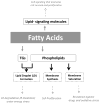Lipogenesis and lipolysis: the pathways exploited by the cancer cells to acquire fatty acids
- PMID: 24001676
- PMCID: PMC4002264
- DOI: 10.1016/j.plipres.2013.08.005
Lipogenesis and lipolysis: the pathways exploited by the cancer cells to acquire fatty acids
Abstract
One of the most important metabolic hallmarks of cancer cells is enhanced lipogenesis. Depending on the tumor type, tumor cells synthesize up to 95% of saturated and mono-unsaturated fatty acids (FA) de novo in spite of sufficient dietary lipid supply. This lipogenic conversion starts early when cells become cancerous and further expands as the tumor cells become more malignant. It is suggested that activation of FA synthesis is required for carcinogenesis and for tumor cell survival. These observations suggest that the enzymes involved in FA synthesis would be rational therapeutic targets for cancer treatment. However, several recent reports have shown that the anti-tumor effects, following inhibition of endogenous FA synthesis in cancer cell lines may be obviated by adding exogenous FAs. Additionally, high intake of dietary fat is reported to be a potential risk factor for development and poor prognosis for certain cancers. Recently it was reported that breast and liposarcoma tumors are equipped for both de novo fatty acid synthesis pathway as well as LPL-mediated extracellular lipolysis. These observations indicate that lipolytically acquired FAs may provide an additional source of FAs for cancer. This review focuses on our current understanding of lipogenic and lipolytic pathways in cancer cell progression.
Keywords: Cancer; Fatty acid synthase; Fatty acid synthesis; Lipogenesis; Lipolysis; Lipoprotein lipase.
Copyright © 2013 Elsevier Ltd. All rights reserved.
Figures


References
-
- Warburg O. On the origin of cancer cells. Science. 1956;123(3191):309–14. - PubMed
-
- Aisenberg AC. The Glycolysis and Respiration of Tumors. Academic Press; New York: 1961. pp. 12–13.
-
- Baron A, et al. Fatty acid synthase: a metabolic oncogene in prostate cancer? J Cell Biochem. 2004;91(1):47–53. - PubMed
-
- Menendez JA, Lupu R. Fatty acid synthase and the lipogenic phenotype in cancer pathogenesis. Nat Rev Cancer. 2007;7(10):763–77. - PubMed
Publication types
MeSH terms
Substances
Grants and funding
LinkOut - more resources
Full Text Sources
Other Literature Sources
Research Materials
Miscellaneous

